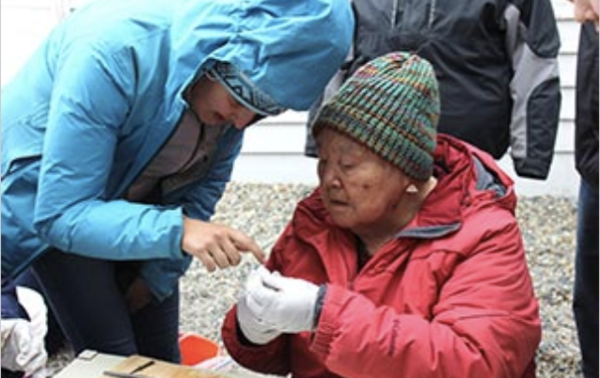Community-Based Science to Protect Future Generations
2:00 pm US Eastern Time
Slides & Resources
Studying Exposure to Legacy Contaminants and Health Effects on Sivuqaa (St Lawrence Island), National Institute of Environmental Health Sciences
For a full listing of resources on this topic, see this page from the webinar host, Alaska Community Action on Toxics.

The recording and slides for this event are now available here.
Since CHE-Alaska's last update on Community Based Participatory Research (CBPR) with the communities of Sivuqaq (traditional name for Saint Lawrence Island) in 2017, an additional five peer-reviewed papers have been published with findings pertaining to the effects of persistent organic pollutants (POP’s) on the Arctic ecosystem, food web, and people.
Concerns over health disparities including cancer, thyroid disease, diabetes, heart disease, and birth defects have motivated members of the Sivuqaq communities of Savoonga and Gambell to investigate the connection between health disparities and environmental contamination from POPs and toxic metals such as mercury.
The Arctic region is disproportionately exposed to POPs through the process of global distillation. Sivuqaq, located in the Arctic, is also subject to contamination from two abandoned cold-war era military sites located on the island. There are diverse sources of POPs and toxic substances on Sivuqaq; leading to ongoing exposures of the Yupik people of Sivuqaq through contaminated air, water, and traditional foods.
This webinar provided an update on these CBPR projects and the latest findings from these studies from Savoonga resident and Community Work Group member Sandra Gologergen and co-authors of these papers, Dr. Sam Byrne (Middlebury College) and Viola Waghiyi (Alaska Community Action on Toxics).
Featured Speakers
Sandra Gologergen was born in 1962 and raised in Savoonga. She cares deeply for the health of the lands and waters of Sivuqaq and for the children. She works to educate younger generations about the importance of protecting the land and to pass on the knowledge she has received from her ancestors. She loves berry picking and serving as a storyteller in the school. Her close knit family includes her five sisters and a brother, 3 children and 2 grandchildren. Sandra serves on the Sivuqaq Working Group that guides all aspects of the Community-Based Research on Sivuqaq.
Viola (“Vi”) Waghiyi is a Yupik grandmother who was born in Savoonga on Sivuqaq (traditional name for St. Lawrence Island). Vi was hired in 2002 to work in Anchorage to assist on the Sivuqaq environmental health and justice projects. She became the Project Coordinator in 2004 and Environmental Justice Community Coordinator in 2005. In 2009, she stepped into the position of Program Director to share responsibilities with the executive director for all of ACAT’s efforts. She served as a National Advisory Environmental Health Sciences Council member to the National Institute of Health and in 2021 was named to the White House Environmental Justice Advisory Council.
Sam Byrne, PhD, is an assistant professor of Biology and Global Health at Middlebury College. He earned an MS and PhD degrees at the University at Albany School of Public Health in the department of Environmental Health Sciences. He is an environmental health scientist with a focus in environmental epidemiology. His research includes the environmental causes of health disparities, health effects of environmental chemicals, and the social and cultural factors which influence exposure to toxic substances.
This call was hosted by the CHE-Alaska Partnership, which is coordinated by Alaska Community Action on Toxics (ACAT).
Photo via NIEHS website: Intern Abigail Nelson, left, and elder Harriet Penayah, right, dissecting stickleback fish for endocrine and histological analysis at a community-based research institute in Gambell, Sivuqaq.


